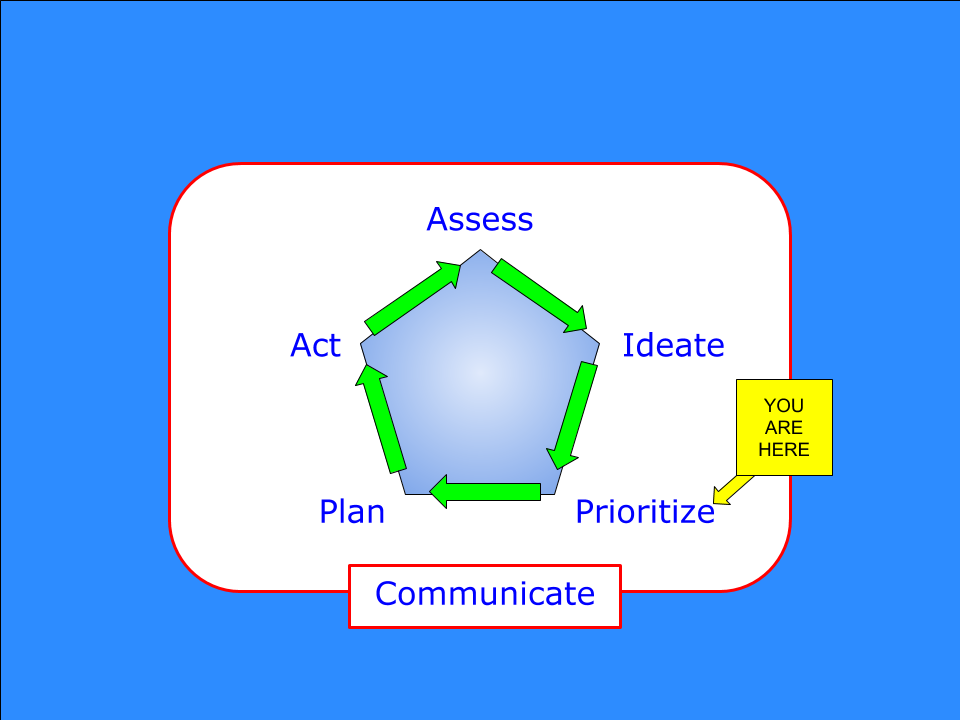Introduction
Prioritization is a critical aspect of any planning process. It’s easy to generate long lists of ideas about what we should do in the future. What’s hard is deciding which ideas to pursue and which ones to postpone. As managers, we know we will never have enough time, money or people to address every good idea.
The third phase in our planning framework is Prioritize. This is where we will make those hard choices.
This is the latest in a series of articles about planning in uncertain times. In the first article, I introduced the framework – a repeatable cycle made up of six phases. The other articles are:
- Phase 1 – Assess
- Phase 2 – Ideate
- Phase 3 – Prioritize – this article
- Phase 4 – Plan
- Phase 5 – Act
- Phase 6 – Communicate

A Quick Recap
Before jumping in to the Prioritize activities, I want to do a quick recap of the earlier phases.
The first phase of the planning cycle is Assess. During that phase, we identify an assessment topic – a significant problem or issue that needs to be addressed in the future. We then conduct an evaluation of the current state of the organization, using the techniques of SWOT and PEST analysis. As a final step, we select the most relevant ideas that addressed the assessment topic.
In the second phase, Ideate, we identify possible actions to address the assessment topic. We create an idea map to capture ideas about how to address each opportunity in the SWOT analysis. We evaluate each of those ideas in context with the strengths that had been identified, the weaknesses that had been identified and the threats. When considering threats, we look at both the risks associated with the threats and possible mitigations. Also in the Ideate phase we capture ideas on how the actions could be implemented using “how-to-do-it” lists. (These ideas are held for later use in the Plan phase.) Finally, we create One Page Summaries of each of the proposed actions. These are the inputs for the Prioritize phase.
In the most recent article in the series, we explored the Communicate phase, a set of tasks that are repeated at the end of each of the other phases. These tasks ensure that the right communications are sent to the right stakeholders at the right time.
Now, let’s get on with the Prioritize phase.
Objectives and Outcomes of Prioritize
The primary objective of this phase is to evaluate the actions that were identified in the Ideate phase, determine which ones should be pursued further and in what order.
The outputs of the Prioritize phase will be:
- A prioritized list of actions to be taken into the plan phase.
- A list of actions to be revisited later.
- Updated One Page Summaries (now multiple pages) that capture decisions and status information. (Download the updated One Page Summary template.)
- Notes on any interdependencies or conflicts between the actions that will need to be resolved in the plan phase.
The Prioritization Process
There are six steps in the Prioritize phase:
- Screen the proposed actions for feasibility.
- Check alignment with mission, vision, values and objectives.
- Decide on the prioritization method.
- Conduct the prioritization.
- Conduct a sanity check on the output.
- Communicate status and results.
We’ll look at each one of these in turn.
Screen the Proposed Actions for Feasibility
This is an opportunity to determine if there are conflicts or issues that would prevent us from moving forward with any of the particular actions. These could be:
- Economic impacts, including the potential costs of action, budgetary constraints and external market factors.
- Timing conflicts with other initiatives.
- Availability of skilled personnel or other needed resources.
- Organizational culture issues.
- Other unexpected external events. (Can you name one?)
If it is apparent that a particular action cannot be acted on, then it should not be taken any further in the prioritization phase. You should update the One Page Summary document with the decision and the reasons for not taking it forward. Categorize the action for consideration at a later time.
Check Alignment with Mission, Vision, Values and Objectives
The second step in the process is to check alignment with your organizational guideposts – your mission statement, vision statement, core values and objectives. For each of the proposed actions, ask this question:
“Does the proposed action conflict with our organization’s mission, vision, values, or objectives?”
Ideally, these conflicts would have been resolved during the Ideate phase, but it’s possible that some may not have been identified. Depending on the time elapsed since the conclusion of the Ideate phase, new information or observations may have emerged.
When a conflict is noted, you have a choice to make. If a resolution seems clear, you can revise the action to eliminate the conflict. But if the issue cannot be resolved, you should document the problem and set the action aside for future consideration, just as you did in the earlier step.
Decide on the Prioritization Method
The third step is to decide on the method to use to prioritize the actions.
There may actually be no decision to make here – the priority might be immediately clear. By doing the feasibility screen and the alignment test, you could have reduced the list of proposed actions to a small number where the priority is readily apparent.
If the proposed actions represent a logical sequence of events, there may not be any need to try to prioritize. In this case, document the priority and move on to the Sanity Check step.
But, if the priority is not clear, you will need to determine what method you will use to prioritize. There are many ways to do this, and your organization may have a standard approach. If you already have a preferred method, then move on to the next step.
If you do not have a standard approach, or you want to try something new, then read the companion article “Prioritization: Two Ways to Get It Right” that I published along with this one. It describes two different approaches to prioritization and includes step-by-step instructions and templates.
Run the Process
The fourth step is to actually run the prioritization process.
As you perform the process, capture notes about any interdependencies between the actions. Also note any unanswered questions as well as assumptions you make and any decisions. The updated One Page Summary document contains sections to capture these details.
Perform a Sanity Check
The fifth step is a sanity check. I found this step was necessary whenever I ran a prioritization process. During the prioritization discussion, teams get very focused on the details. They’re “down in the weeds” and may temporarily forget the broader objective.
So when you’re done it’s important to step back and look at the output holistically. Ask the simple question “Does the result make sense?”
This is not to suggest that, if you don’t like the outcome, you should go back and tinker with the values to make it come out the way you want. It’s not about enforcing a predetermined outcome. When done correctly, a prioritization exercise should result in a list that is a bit surprising. After all, if the priority was evident, you wouldn’t have needed to run a process.
But there is the possibility that, after the process has been run and the results are revealed, you or your team members might see a need to rethink particular positions. You may determine that you missed something.
The sanity check step allows you to identify these concerns and resolve them. If necessary, back up in the process and repeat some of the earlier steps. This could mean going back and challenging your logic or assumptions, then documenting the reasons why you reached a different decision.
Do this carefully. Changing the outcome can defeat the purpose of running the exercise, particularly if someone’s pet project has ended up low on the prioritized list. This is where a strong facilitator may have to step in.
Two tactics for managing this are:
- Tell the group, up front, that the results of the process will not be modified.
- Insist on a reflection period of 2 – 3 days between the completion of the process and any adjustments.
Communicate Status and Results
The last step in the process is to communicate status and results, using the guidance published in the Communicate phase article. As a reminder, the six steps in Communicate are:
- Update your stakeholder analysis.
- Ask the six questions – Why? Who? What? How? Where? When?
- Update the communication plan.
- Create message triangles.
- Create the communication materials.
- Deliver the messages.
The prioritization process will generate several items that may be included in communications to various stakeholder groups. These are the prioritized list of actions to be to be taken, the updated One Page Summaries and a list of any interdependencies or unresolved conflicts that were noted during the prioritization discussion.
Conclusion
With the Prioritize phase completed, you have not reached another significant milestone in the planning cycle. You have developed, clarified and vetted a set of proposed actions to address the assessment topic – the issue or problem you set out to solve. In the next phase, Plan, we will look at the different aspects of creating an actionable plan to put those actions into place.
To your success,


What’s on your mind today?
Do you have a management problem or question that I could help answer?
If so, then let’s talk.
Click the button below and use the Contact form to request a complementary 30 minute chat. We’ll work together to identify some actionable ideas just for you.
